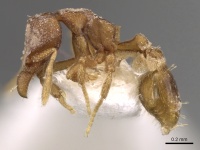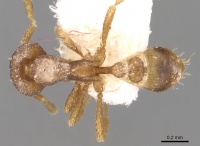Strumigenys extemena
| Strumigenys extemena | |
|---|---|

| |
| Scientific classification | |
| Kingdom: | Animalia |
| Phylum: | Arthropoda |
| Class: | Insecta |
| Order: | Hymenoptera |
| Family: | Formicidae |
| Subfamily: | Myrmicinae |
| Tribe: | Attini |
| Genus: | Strumigenys |
| Species: | S. extemena |
| Binomial name | |
| Strumigenys extemena (Taylor, 1968) | |
The sparse collections and associated label information yield some anecdotal biological information: litter sampling and one noted habitat of "degraded coastal hill forest on granite."
Identification
Bolton (2000) - A member of the Strumigenys extemena-group. Within the group extemena is unique in its possession of small appressed scale-like hairs on the clypeus, on the cephalic dorsum immediately behind the clypeus and on the scapes. Such pilosity is absent or differently arranged in the other eight species. The petiole node in dorsal view (excluding the spongiform tissue) is about as broad as long in extemena but is conspicuously broader than long elsewhere in the group.
Only Strumigenys deinognatha has mandibles constructed the same as extemena. In both these species the masticatory margins are considerably elevated above the level of the outer margins, so that the dorsal surfaces fall away steeply on each side of the midline and the closed mandibles together are triangular in section or frontal view. Separation of these two is based on the characters given in the key.
Like Strumigenys carinognatha, Strumigenys atopogenys, Strumigenys ocypete and Strumigenys podarge, extemena has a transverse ridge across the widest point of the vertex and lacks standing hairs on the dorsal alitrunk. But in ocypete and podarge the scape at its widest point has a conspicuous large, anteriorly projecting specialised hair, elongate and remiform in podarge, flat and broadly scale-like in ocypete. In this respect extemena resembles Strumigenys acheron and Strumigenys aello where no specialised hair appears at this point, merely a continuation of the row of small curved hairs that occupies the remainder of the scape's leading edge.
The species acheron and aello have standing straight hairs present near the pronotal humeri and a single pair anteriorly on the mesonotum, and the former has a transverse ridge on the head that is as well developed as in extemena. These two species possess transverse rows of standing hairs on the vertex, with 4 hairs in a row. S. aello has two such rows, one across the highest point of the vertex and the second closer to the occipital margin, whilst acheron has only a single row close to the occipital margin. In extemena there are no standing hairs anywhere on the cephalic dorsum. Finally, the very distinct carinognatha, atopogenys and tarbosyne are immediately isolated by the structure of the basidorsal mandible, discussed under those species.
Like other members of the group extemena has a short, broad head and relatively long mandibles, CI 89, MI 38, with HW 0.40-0.41 and SL 0.24 (after Taylor, 1968b).
Keys including this Species
Distribution
Latitudinal Distribution Pattern
Latitudinal Range: 1.383329988° to 1.383329988°.
| North Temperate |
North Subtropical |
Tropical | South Subtropical |
South Temperate |
- Source: AntMaps
Distribution based on Regional Taxon Lists
Indo-Australian Region: Borneo, Indonesia, Malaysia, Singapore (type locality).
Distribution based on AntMaps
Distribution based on AntWeb specimens
Check data from AntWeb
Countries Occupied
| Number of countries occupied by this species based on AntWiki Regional Taxon Lists. In general, fewer countries occupied indicates a narrower range, while more countries indicates a more widespread species. |

|
Estimated Abundance
| Relative abundance based on number of AntMaps records per species (this species within the purple bar). Fewer records (to the left) indicates a less abundant/encountered species while more records (to the right) indicates more abundant/encountered species. |

|
Biology
Castes
Nomenclature
The following information is derived from Barry Bolton's Online Catalogue of the Ants of the World.
- extemena. Dysedrognathus extemenus Taylor, 1968d: 133, figs. 3, 4 (w.) SINGAPORE. Combination in Pyramica: Bolton, 1999: 1672; in Strumigenys: Baroni Urbani & De Andrade, 2007: 119. See also: Bolton, 2000: 419.
Unless otherwise noted the text for the remainder of this section is reported from the publication that includes the original description.
Description
Type Material
Bolton (2000) - Holotype worker and paratype worker, SINGAPORE: Bukit Timah Nature Reserve, 8.iii.1965, berlesate no. B45, leafmould on granite, degraded coastal hill forest (D. H. Murphy) (Australian National Insect Collection, Museum of Comparative Zoology) [examined].
- Dysedrognathus extemenus Taylor, 1968: Holotype, worker, Bukit Timah Nature Reserve, Singapore, Murphy,D.H., ANIC32-001163, Australian National Insect Collection.
References
- Baroni Urbani, C. & De Andrade, M.L. 2007. The ant tribe Dacetini: limits and constituent genera, with descriptions of new species. Annali del Museo Civico di Storia Naturale “G. Doria” 99:1-191.
- Bolton, B. 1998b. A preliminary analysis of the ants of the Pasoh Forest Reserve. Pp. 84-95 in: Lee, S. S.; Dan, Y. M.; Gauld, I. D.; Bishop, J. (eds.) Conservation, management and development of forest resources. Proceedings of the Malaysia-United Kingd (page 92, combination in Trichoscapa)
- Bolton, B. 1999. Ant genera of the tribe Dacetonini (Hymenoptera: Formicidae). J. Nat. Hist. 3 33: 1639-1689 (page 1672, combination in Pyramica)
- Bolton, B. 2000. The ant tribe Dacetini. Memoirs of the American Entomological Institute. 65:1-1028. (page 419, redescription of worker)
- Taylor, R. W. 1968e. A new Malayan species of the ant genus Epitritus, and a related new genus from Singapore (Hymenoptera: Formicidae). J. Aust. Entomol. Soc. 7: 130-134 (page 133, figs. 3, 4 worker described)
- Wang, W.Y., Soh, E.J.Y., Yong, G.W.J., Wong, M.K.L., Benoit Guénard, Economo, E.P., Yamane, S. 2022. Remarkable diversity in a little red dot: a comprehensive checklist of known ant species in Singapore (Hymenoptera: Formicidae) with notes on ecology and taxonomy. Asian Myrmecology 15: e015006 (doi:10.20362/am.015006).
References based on Global Ant Biodiversity Informatics
- Malsch A. K. F., K. Rosciszewski, and U. Maschwitz. 2003. The ant species richness and diversity of a primary lowland rain forest, the Pasoh Forest reserve, West Malaysia. in T. Okuda, N. Manokaran, Y. Matsumoto, K. Niiyama, S. C. Thomas, and P. S. Ashton, eds. Pasoh: Ecology and Natural History of a Southeast Asin Lowland Tropical Rain Forest, pp 347-374.
- Malsch A.T.K., B. Fiala, U. Maschwitz, M. Mohamed, J. Nais, and K. E. Linsenmair. 2008. An analysis of declining ant species richness with increasing elevation at Mount Kinabalu, Sabah, Borneo. Asian Myrmecology 2: 33-49.
- Pfeiffer M.; Mezger, D.; Hosoishi, S.; Bakhtiar, E. Y.; Kohout, R. J. 2011. The Formicidae of Borneo (Insecta: Hymenoptera): a preliminary species list. Asian Myrmecology 4:9-58

